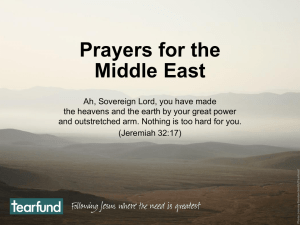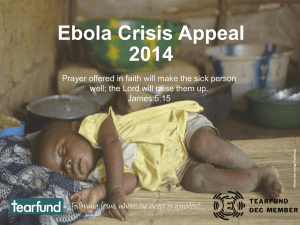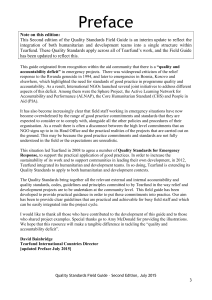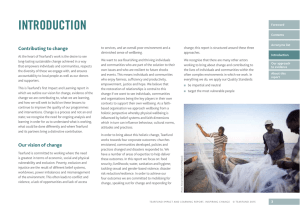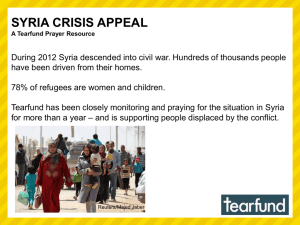RESPONDING FOR CHANGE OUR APPROACHES TO CHANGE PART ONE
advertisement
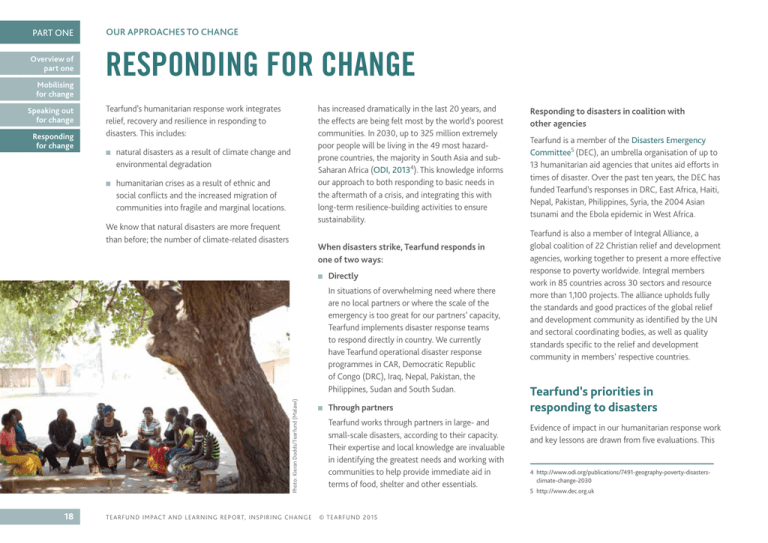
PART ONE OUR APPROACHES TO CHANGE Overview of part one RESPONDING FOR CHANGE Mobilising for change Speaking out for change Responding for change Tearfund’s humanitarian response work integrates relief, recovery and resilience in responding to disasters. This includes: ■ ■ has increased dramatically in the last 20 years, and the effects are being felt most by the world’s poorest communities. In 2030, up to 325 million extremely poor people will be living in the 49 most hazardprone countries, the majority in South Asia and subSaharan Africa (ODI, 20134). This knowledge informs our approach to both responding to basic needs in the aftermath of a crisis, and integrating this with long-term resilience-building activities to ensure sustainability. natural disasters as a result of climate change and environmental degradation humanitarian crises as a result of ethnic and social conflicts and the increased migration of communities into fragile and marginal locations. We know that natural disasters are more frequent than before; the number of climate-related disasters When disasters strike, Tearfund responds in one of two ways: ■ Directly Photo: Kieran Dodds/Tearfund (Malawi) In situations of overwhelming need where there are no local partners or where the scale of the emergency is too great for our partners’ capacity, Tearfund implements disaster response teams to respond directly in country. We currently have Tearfund operational disaster response programmes in CAR, Democratic Republic of Congo (DRC), Iraq, Nepal, Pakistan, the Philippines, Sudan and South Sudan. 18 T E A RF U ND IMPACT AND LEARN ING REPORT, I NSPI R ING CHA NGE ■ Through partners Tearfund works through partners in large- and small-scale disasters, according to their capacity. Their expertise and local knowledge are invaluable in identifying the greatest needs and working with communities to help provide immediate aid in terms of food, shelter and other essentials. © T EA R FUND 20 15 Responding to disasters in coalition with other agencies Tearfund is a member of the Disasters Emergency Committee5 (DEC), an umbrella organisation of up to 13 humanitarian aid agencies that unites aid efforts in times of disaster. Over the past ten years, the DEC has funded Tearfund’s responses in DRC, East Africa, Haiti, Nepal, Pakistan, Philippines, Syria, the 2004 Asian tsunami and the Ebola epidemic in West Africa. Tearfund is also a member of Integral Alliance, a global coalition of 22 Christian relief and development agencies, working together to present a more effective response to poverty worldwide. Integral members work in 85 countries across 30 sectors and resource more than 1,100 projects. The alliance upholds fully the standards and good practices of the global relief and development community as identified by the UN and sectoral coordinating bodies, as well as quality standards specific to the relief and development community in members’ respective countries. Tearfund’s priorities in responding to disasters Evidence of impact in our humanitarian response work and key lessons are drawn from five evaluations. This 4 http://www.odi.org/publications/7491-geography-poverty-disastersclimate-change-2030 5 http://www.dec.org.uk OUR APPROACHES TO CHANGE A commitment to building sustainability through community engagement, even in the most isolated areas Tearfund is responding to the needs of communities where there are few other organisations doing the same. Our ten-year review of programmes in Darfur demonstrates the way Tearfund has adjusted its geographical focus in Darfur to coincide with changing needs. Tearfund’s Sudan team elected to work in some of the most isolated areas of Darfur with the most intense needs and where there was very little support from other NGOs. Tearfund’s approach in Darfur was commended by an independent body for its emphasis on building sustainability through community engagement: ‘We find that Tearfund has responded much better to the protracted nature of the Darfur conflict than [others], minimising dependence and investing in building sustainable capacity in its target communities… Tearfund’s community engagement approach offers a real prospect of sustainable impact.’6 Since 2004, Tearfund’s projects in Darfur have provided vital services to almost three million beneficiaries in some of the most remote, insecure and badly affected parts of Darfur. The project was designed to bridge the emergency and early recovery phases of the humanitarian response. Therefore, Tearfund’s programmes have combined the delivery of critical life-saving emergency inputs in the sectors of nutrition, water, sanitation and health promotion with longer-impact work in the areas of education, food security and community development. The programmes have been delivered with a high degree of community participation and in close coordination with government agencies. Tearfund spent more than £39 million in Darfur between 2004 and 2012, more than £4.5m per year, with the largest proportion of funds coming from the European Commission for Humanitarian Aid (ECHO), The Office of US Foreign Disaster Assistance (OFDA) and DFID. 2013, Tearfund had raised £1.8 million to implement programmes to support Syrian refugees in Jordan and Lebanon. In Lebanon, one organisation that Tearfund partnered with delivered food parcels, and three organisations in Jordan delivered food parcels, conditional cash-for-rent assistance, psycho-social trauma counselling and child-friendly spaces for Syrian refugee children. Overview of part one Mobilising for change Speaking out for change Responding for change An RTR was undertaken in August 2013 to assess progress seven months into the response. The review found that the immediate needs of refugee families were being addressed through food distributions, nonfood items (NFI), cash-for-rent and the installation of water, sanitation and hygiene (WASH) facilities in the refugee camps. Crucially, there was also support Integration of relief, recovery and resilience in our response to disasters Tearfund is committed not only to meeting the shortterm basic needs of those affected by disasters but also to working with individuals and communities to ensure their wellbeing in the long term. This means implementing activities which will ensure full recovery and build resilience, protecting them from future shocks and stresses. (See the Building resilience section, page 39, for more detail about this specific aspect of our work.) In early 2013, Tearfund launched an appeal to respond to the worsening crisis in Syria; this was followed by a DEC appeal launched in March 2013. By May 6 ICAI, 2013, DFID’s Water, Sanitation and Hygiene Programming in Sudan: pp 1, 10 Photo: Marcus Perkins/Tearfund (Philippines) includes Real Time Reviews (RTRs) from our responses in Syria and Philippines, programme evaluations from Pakistan, the Sahel and the Horn of Africa, and a tenyear review of our response to the crisis in Darfur, Sudan. We also incorporate the findings of an external evaluation report from Darfur which reinforces the evidence from Tearfund’s Darfur ten-year review. PART ONE T EA R FUND I M PACT A ND L E AR NI N G R E P O RT, I N SP I R IN G C H AN GE © T E AR FU N D 201 5 19 PART ONE Overview of part one Mobilising for change Speaking out for change Responding for change OUR APPROACHES TO CHANGE being given to the recovery and resilience of both refugee families and local partners; an emphasis on learning and capacity building for partners aimed to improve their ability to respond to future disasters, an ongoing challenge for the NGO community. In Jordan, a Tearfund partner delivered psycho-social support and counselling to Syrian refugees as many of them had been through intense trauma and needed support to overcome the fears they carried with them. This holistic approach to humanitarian response aims to provide for longer-term impact by going beyond the provision of basic needs, with emphasis on building resilience for the future. Our response to Typhoon Haiyan in the Philippines in 2013 (see below) is another example of our work to build longer-term resilience of communities through the design of stronger shelters. Building capacity of local actors to deal with future disasters A challenging yet critical part of building resilience and sustainability within the humanitarian sector involves improving the capacity of local partner organisations to be able to respond to future disasters. This is especially important as there are often great demands placed on small local organisations when a disaster strikes, and they need to be prepared. An RTR of Tearfund’s response to Typhoon Haiyan which struck the Philippines in November 2013 presents some useful learning on building local partner capacity. Tearfund worked through five local partners in the Philippines with a commitment to provide additional capacity to partners where there were gaps in capacity. The review (conducted four months into the response) concluded that a 20 T E A RF U ND IMPACT AND LEARN ING REPORT, I NSPI R ING CHA NGE To share learning and facilitate discussions between agencies on this issue, Tearfund hosts the Active Learning Network for Accountability and Performance’s (ALNAP) Community of Practice on ‘Partnerships and Local Capacity in Emergencies’, which currently has more than 200 members from 56 countries. significant and enduring impact of the response would be in the developed skills of the communities, councils and partners with whom Tearfund has worked. A training programme provided to Tearfund partners in Manila and Tacloban on Tearfund’s Quality Standards was highly rated by partners and there was clear evidence that the principles promoted by the training were translated into actions on the ground. Partners introduced new policies and approaches to accountability as a direct result of the training. ‘Key lessons’ from Tearfund and four other agencies who responded to Typhoon Haiyan were published in the September 2014 report, Missed again: making space for humanitarian partnership in the Typhoon Haiyan response. The report highlights some of the challenges identified in relation to working through partnerships, including the tendency of INGOs to prioritise direct delivery over partnerships and the resulting difficulty in taking partnerships to scale. Tearfund will continue to work in collaboration with other agencies to share best practice to inform our ongoing work. © T EA R FUND 20 15 Cаe S"# Preparing for the winter months in Iraq The use of cash and vouchers in emergencies is an established and growing trend across the global humanitarian sector. Where appropriate, cash transfer programming (CTP) can offer a number of advantages over traditional in-kind distributions and in recent years national and international NGOs have moved increasingly towards CTP to meet needs more effectively in emergencies. Tearfund partners and operational teams have been implementing a wide variety of cash and voucher programmes for a number of years. The following case study from Iraq highlights one example of our cash voucher programming. Northern Iraq The conflict in northern Iraq intensified in June 2014, causing mass displacement and widespread humanitarian needs among people in the region. In total, an estimated 946,266 individuals fled to the Kurdish Region of Iraq (KR-I) from insecure areas, often arriving with very few possessions. This influx, in addition to the quarter of a million Syrian refugees already residing in KR-I, put significant pressure on resources and on the host population. Newly displaced families took refuge in abandoned or unfinished buildings, built makeshift shelter in open spaces, occupied tents or took refuge with host families. With winter approaching, many families faced an extremely difficult situation living OUR APPROACHES TO CHANGE in unsuitable accommodation and lacking essential items such as heating fuel, clothes, bedding etc. Tearfund’s response Tearfund conducted a needs assessment among internally displaced persons (IDPs) in KR-I and found that their number one concern was inadequate shelter, followed by the lack of heating/fuel and warm clothes to help them survive the oncoming winter. Many families were already beginning to experience the effects of harsh weather conditions as the unfinished or makeshift structures they were sheltering in were damaged by rain. A market assessment looking at non-food items (NFIs) for the winter season found that markets were accessible and the required products were available. Financial institutions were also found to be operational and security was considered stable enough to allow for safe delivery of cash assistance. Accordingly, Tearfund’s operational team decided to implement an emergency cash assistance programme to reduce the vulnerability of IDPs during the winter months. Although most IDPs articulated the same general needs, the specific needs within these categories varied from family to family. With a cash grant they were able to address a range of needs far greater than with any in-kind ‘shelter sealing kit’ or ‘NFI kit’, and The Hawala system is an informal money transfer process, operated through an extensive network of money brokers (Hawala agents) and widely used throughout the Middle East, North Africa and the Horn of Africa. K! L"#$ their dependency on distributions was reduced. One recipient explained: ‘This is the best kind of help we could have received as each family has its own unique needs and priorities. For example, many families have members in need of specific medical assistance.’ Tearfund developed good working relations with the leaders of the targeted villages and sub-district, which made it easier to identify IDPs. In total, 562 displaced families (an estimated 3,637 individuals) were selected based on family surveys and visits conducted by Tearfund staff. Families were given varying amounts depending on their size ($200 for small families, $500 for medium-sized, and $700 for large ones) as agreed by the Cash Working Group (a group that helps to coordinate cash transfer programmes) and local authorities. The amounts were calculated to cover the cost of essential items and a proportion of the fuel needed for the winter months. In this specific context, different cash delivery methods were considered, including the banking system, formal money transfer agents such as Western Union, and the Hawala system (see box). The Hawala system was finally selected as the preferred mechanism for distribution, having been successfully used in cash transfer programmes by other INGOs who had found it to be reliable, efficient and secure. Delivering direct cash through the Hawala system has the additional advantage of being fast, and easy to access and use. PART ONE Overview of part one Mobilising for change Ensure the most vulnerable people can access cash distributions ✓ Speaking out for change Responding for change Despite initial assurances from elderly beneficiaries that the selected distribution point was accessible for them, in the end many of them struggled to travel to the distribution point. As a result, the team explored alternative solutions to ensure the process would be more suitable for the elderly in future programming. ✓ Coordination with national NGOs is vital Any INGO response must be designed to complement the work of national NGOs as these organisations bring considerable capacity, local knowledge and experience and will be present for the long term. T EA R FUND I M PACT A ND L E AR NI N G R E P O RT, I N SP I R IN G C H AN GE © T E AR FU N D 201 5 21
